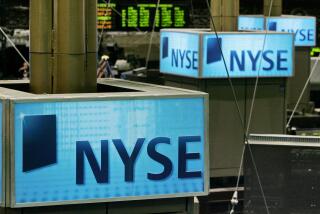For Bears, This High Is Too High
- Share via
Wall Street’s bears won’t argue with the strength of first-quarter corporate earnings. They simply think that stock prices already fully reflect those earnings, plus any additional good profit news this year.
In other words, the bears think the market is fairly priced or overpriced. So with every new gain in stock prices--the Dow industrial average jumped 39.43 points to a record 4,270.09 on Friday, and is up 11% this year--the bear case is that the market is increasingly setting itself up for a fall.
But what constitutes “fair” valuation in stock prices? That’s the problem. Valuation is in the eyes of the beholder, and also is a moving target affected by interest rates, inflation and other factors.
The relationship of share prices to underlying earnings (the “price-to-earnings” or P-E ratio) is the most common valuation yardstick, but analysts also look at share prices versus dividends or versus “book” or net asset value per share, among others.
The Minneapolis-based investment firm Leuthold Group, which has been bearish for many months, argues that by almost any measure the stock market is overvalued. The average blue-chip stock need only rise 7% more to reach the sky-high valuations of 1987 that precipitated the market crash, the firm contends.
Yet if corporate earnings and dividends grow faster than expected this year, then stock prices have room to rise without pushing current stock P-Es higher. That’s simple math: If you move the “E” you can move “P” without affecting the ratio.
Abby J. Cohen, investment strategist at Goldman, Sachs & Co., figures that the P-E of the average U.S. blue-chip stock now is about 14 based on estimated 1995 earnings. Historically, she says, blue-chip P-Es have been closer to 16.5 in times of low inflation. So if you expect inflation (and thus interest rates) to stay under control, stock prices can rise even if corporate earnings grow more slowly, she argues.
More to Read
Inside the business of entertainment
The Wide Shot brings you news, analysis and insights on everything from streaming wars to production — and what it all means for the future.
You may occasionally receive promotional content from the Los Angeles Times.










